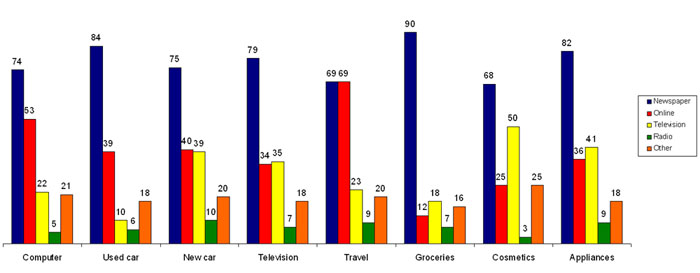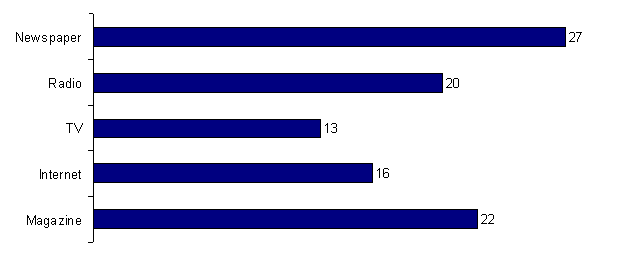|
Writing and Editing
> White Paper: Print Isn't Dead Yet
"Today we are living in the late age of print" (Bolter
2). Some may take this to mean that print is dead or near the
end. Studies show that print advertising produces better return
on investment over all other forms of advertising, including online.
Bolter clarifies that "the term 'late' does not mean that
print technology is necessarily about to disappear" (Bolter
210). As long as advertisers see a return from their print advertisement,
they will keep funding this medium.
Through the years newspaper ad expenditures have experienced
ups and downs. However, overall from 1950 to 2006, print ad spending
has increased over 290 per cent. There has never been double-digit
negative growth, yet the early 80s and late 90s had double-digit
growth numerous times. Even as late as 2000, print ad expenditure
experienced growth of 13.7 per cent (NAA Ad Expenditures).
A Long Way From Death’s Bed
From an advertisers perspective print is an effective medium.
Even with print advertising numbers down from the previous year,
newspapers are still the largest advertising medium. Internet
advertising made up only 5.4 per cent of total advertising revenues
last year, according to the Newspaper
Association of America (NAA) figures (NAA Online).
The NAA reports the following advertising expenditures for 2006
(Marketing Daily):
- Print advertising: US$46.6
billion (down 1.7 per cent from 2005)
- Online advertising: US$2.7
billion (up 31.5 per cent from 2005)
Print is not new (far from it), so it isn’t going to experience
the huge growth that a new technology or medium, such as the Internet,
would experience.
Less Annoying
| Newspaper Reader is More Engaged
| Effective Way to Convey Information
| High Consumption Rate
| Conclusion | Facts and Figures
| References
Return
to top
Less Annoying
Readers remain loyal to their paper and trust it thus they build
an emotional attachment and are more susceptible to receiving
an advertising message (Print 2006).
According to the “How Powerful is Print 2006” report, 10 per
cent of people surveyed find magazine advertising annoying compared
to 51 per cent who find television ads annoying.
A Leger Marketing study found that four out of five Canadians
think advertising in newspapers is more acceptable than any other
form of advertising (Print 2005).
Media Saturation – What Is Acceptable To Canadians (Print 2005)
|
Advertising Technique
|
2003
|
2004
|
|
Print advertising in newspapers
|
81%
|
78%
|
|
|
Radio advertising
|
77%
|
72%
|
|
|
Posters on buses or subways
|
75%
|
70%
|
|
|
Television advertising
|
72%
|
68%
|
|
|
Billboards along the roads
|
63%
|
56%
|
|
|
Product placement in television shows
|
56%
|
53%
|
|
|
Ads in washrooms
|
46%
|
47%
|
|
|
Banner advertising on the Internet
|
34%
|
31%
|
|
|
Ads placed on personal property, like baby carriages
|
32%
|
29%
|
|
|
Ads on cell phone displays
|
25%
|
20%
|
|
|
Famous people appearing on talk shows and praising
prescription drugs without mentioning they are paid
|
20%
|
20%
|
|
|
Pop up windows with advertising on the Internet
|
17%
|
12%
|
|
Return
to top
The Newspaper Reader Is More Engaged
Print isn’t a passive medium. Readers are typically highly engaged
when reading a newspaper or magazine. Television and radio are
passive in that consumers sit back and experience it, not always
giving it their complete attention and thus not necessarily absorbing
a particular advertising message.
“Engagement improves return on investment,” says Jack Kliger,
president and chief executive of Hachette Filipacchi Media U.S.
He says, when people are reading magazines, they are unlikely
to be using any other form of media. By contrast, when they watch
television, listen to the radio or surf the Internet, they are
usually multi-tasking, listening to or watching something else
at the same time (Seelye).
People are also fast-forwarding through commercials and deleting
pop-up ads as they see these as intrusions. However, magazine
readers often see ads as part of the magazine (Seelye).
Return
to top
Effective Way to Convey Information
Print aids more in purchase decisions than other media (Print
2006). A Leger Marketing study found that consumers
consult newspapers to aid purchase decision more often than all
other mediums for all products surveyed. The exception was travel,
which Internet tied with print in its influence on purchase decision.
Actual Media Used In Purchase Decision (Print 2006)

For print ads, the message lasts and the consumer can experience
and study it at their leisure. An advertiser’s website address
is right there for the client to type in to a browser. With radio
or television, the message is transient and replaced quickly by
the next ad.
Print can be a part of a complete multi-media campaign. It can
provide the means to advertise a new product offering to consumers
and inform them to visit a website or store for more information.
It can provide space for more information, such as a television
ad for a new medicine that directs the consumer to a particular
magazine for further details.
The Source for Products in Which Consumers are Interested in
(Print 2006)

Consumers use newspapers as a source for product information
more than any other medium, including the Internet (Print 2006).
Return
to top
High Consumption Rate
Newspapers are cheap (often free), accessible and portable. They
can easily be consumed during a morning coffee, a daily commute,
or in a coffee shop.
According to a study released by Hill
Strategies Research in 2005, Canadians spend nearly $23 billion
on cultural activities each year, 20 per cent ($4.6 billion) of
this is on reading materials (Print 2006).
Many publications are now available
online, but print is still a popular choice by readers of all
ages. A study by the Kaiser Family Foundation in the U.S.
found that in a typical day almost half of all eight to 18 year
olds read magazines and another third of them typically read a
newspaper (Print 2005).
Distribution of Print Newspapers and Magazines in Canada
(Media Digest 06/07)
|
Number of Papers
|
Total Circulation
|
|
Daily newspapers
|
134
|
6.4 million
|
|
|
Community newspapers
|
1100
|
15 million
|
|
|
Consumer magazines
(segmented into 46 categories)
|
800
|
64 million
|
|
|
Business publications and trade journals
|
900
|
|
For comparison (Media Digest 06/07):
- Canadian population: 32.5 million (2006 estimate)
- Number of households: 12.8 million (2006 estimate)
Return
to top
Conclusion
It may be "the late age of print," but print isn't
dead yet. Frederic Jameson writes, "[w]hat 'late' generally
conveys is rather the sense that something has changed, that things
are different" (Bolter 3). Print "[will] continue to
survive and even prosper for an undetermined future" (Bolter
210).
With many consumers accepting of print advertising, and engaged
in a media that they trust, newspapers and magazines will continue
to be an effective way for advertisers to convey information for
a long time to come.
Return
to top
Facts And Figures
Media Digest 06/07:
- 45 per cent of Canadian households receive a daily newspaper
- 69 per cent of adults read the last issue of their community
newspaper
- 81 per cent of Canadians 12 and up read a magazine in a month
How Powerful is Print 2006
- 85 per cent of Canadians state that they read a newspaper
or magazine on a regular basis
- 50 per cent of all adults read a daily newspaper everyday
- 31.4 million daily newspapers are sold per week
- Newspaper ads get twice as much attention compared to television
ads
Return
to top
References
(All online references accessed March 17, 2007.)
- Bolter, Jay David. Writing Space: Computers, Hypertext,
and the Remediation of Print. New Jersey: Lawrence Erlbaum
Associates, 2001.
- How
Powerful is Print 2005. Marketing, 2005.
- How Powerful is Print 2006. Marketing, 2006.
- Media Digest 06/07. Canadian Media Director’s Council,
2007.
Return to top
|